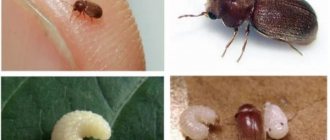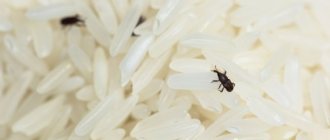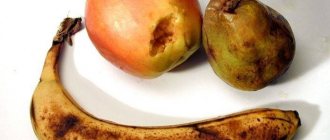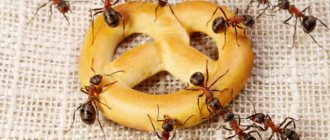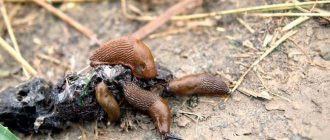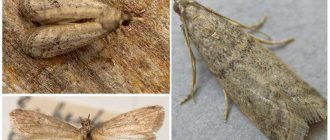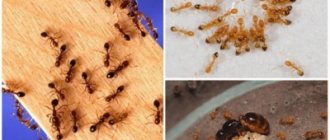What bugs are found in the kitchen and how do they get there?
It’s not enough to discover that there are bugs in flour and cereals, damaging products with lightning speed. To choose effective pest control products, you need to clearly know what type they belong to. There are several main types of bugs that damage bulk products:
- bread grinder;
- flour bug;
- red mucous eater;
- food moth.
Bread grinders are miniature light brown bugs that can fly; they most often settle in cereals; they enjoy baked goods, old medicinal herbs, as well as tea and coffee with great pleasure. They enter the apartment with contaminated store products, as well as animal feed.
Flour bugs settle in flour more often than in any other product; they can often be found in bags of starch. Insects simply penetrate boxes in the kitchen with bulk products, including packages of rye, rice flour, rolled oats and semolina. Infrequently, you can see pests in dried fruits, rice or buckwheat.
The peculiarity of insects is the ability to reproduce quickly. Female beetles camouflage their oviposition in crevices of furniture in the kitchen, in cereals, flour, and on cabinet shelves. A new generation of pests quickly spreads throughout the home in search of food sources.
The red common mucoed is no more than 2.5 mm long. It most often enters the premises together with low-quality animal feed. The pest’s favorite food is cereals, grains, flour with an expired shelf life and a moisture content of no more than 15%. In order for the red flour beetle to stop spoiling food and breeding in the kitchen, it is enough to block access to food sources.
The food moth infests in buckwheat, rolled oats, semolina, rice, flour. A mature individual visually resembles a silver butterfly and reaches a length of 10 cm. Its appearance in the kitchen is associated with violation of food storage rules; in addition, the insect enters the house through ventilation holes and open windows.
It is not difficult to identify pests in products - they leave behind a thin web woven from small yellow worms.
What kind of pest is this
The red flour beetle is found in mills, bakeries, cereal and processing plants. Dry grain with a moisture content of 15% or more is not damaged by the bug. It feeds on rotten spoiled grains. For this reason, it is difficult for him to find suitable food in the apartment.
Most likely, he himself will die without finding suitable living conditions. Farmers and rural residents who raise livestock may encounter the red mucous beetle. The insect is found in stocks of grain, feed and low-quality cereals. Bread grinders are light brown bugs. Small – up to 3 mm.
Usually found on window sills. At home they can eat tea, coffee, and dried medicinal herbs. I like the bindings of books. They can also appear in animal feed - compound feed, crushed grain mixtures.
Very often, small dark bugs infest household supplies of cereals and flour. In science they are called Oryzaephilus surinamensis Surinamese mucoed, popularly - simply mucoed, flour beetle. Body length does not exceed 3.5 mm. Dark, almost black body color with a red tint. A dense shell protects the back and head. The body is divided into 2 parts.
What to do if there are bugs?
In the Middle Ages, people believed that household pests originated from dirt. And even though today we know that this is not so, often, when we encounter insects in the kitchen, we blame ourselves for uncleanliness. Alas, bugs can appear even in exemplary housewives. They get into the house like this:
- brought with cereals, especially by weight;
- penetrate with food packaging (flour bags, etc.);
- fly in from neighbors.
Insects are attracted by scattered cereals, crumbs, other food debris, and also secluded places - cracks in wood. That's why they settle in the kitchen.
If the uninvited tenants are not detected in time, they will multiply and crawl from the kitchen into adjacent rooms: the pantry or the living room, where the owners like to munch in front of the TV.
First of all, check all the products. Most often, housewives remember flour and cereals, but insects can hide in other places.
Where to look for bugs?
Bugs are nosy and almost omnivorous insects. Therefore, if you catch your eye at least one, you need to urgently organize an audit and look for them in all sorts of “hiding places”:
- beans - favorite habitat;
- bread;
- flour and cereals;
- dried fruits;
- spices (they even live in pepper bags);
- vegetables (soft rotting onions are a reason to take a closer look);
- tea and coffee;
- cookie;
- cracks in furniture and window sills;
- kitchen appliances;
- first aid kit (bugs are susceptible to mustard plasters).
We suggest you read: How to get rid of weevils in an apartment
After a thorough inspection of the house, you need to do the following:
- If few insects are found, some of the products can be saved by calcining them in the oven or keeping them in the freezer for a day (then the flour or cereal must be sifted through a sieve). Heavily contaminated supplies will have to be disposed of.
Legumes need to be immersed in salt water and wait until the beetles and their offspring float to the surface, after which the water should be drained and the grains dried.
The garbage along with the bugs must be taken out immediately before they crawl into the cracks of the floor.
- Place unaffected products into glass jars and close tightly.
- Clear the cabinets of food and rinse with vinegar water (1 teaspoon per liter).
- Disinfect all rooms to prevent insects from breeding. Pouring boiling water into the cracks (for wooden floors) gives good results.
The main thing is to make sure that all insect habitats are declassified.
Clear shelves and jars
Now you should thoroughly clean the empty kitchen cabinet and its surroundings, paying special attention to cracks and corners.
- Use a vacuum cleaner to suck up bugs, their larvae, and excrement hiding in the cracks. After this procedure, the vacuum cleaner bag should be thrown away or, after emptying it, “frozen” for 3-4 days to prevent re-infection.
- Do not use laundry detergents, bleaches, ammonia, or chlorine-containing cleaners. They will have no effect on kitchen pests.
- Don’t forget to wash and treat the container in which the spoiled cereal was stored with cold or heat.
Vacuuming should be enough to remove all traces of beetles, but it is also recommended to wipe down the shelf with laundry soap and then vinegar diluted in water.
How to prevent insects from appearing?
To prevent insects in cereals from complicating your life by requiring a number of operations to destroy them, you can follow simple recommendations regarding the prevention of their appearance. These include:
- Warm up the purchased cereals in the oven at low temperature for half an hour.
- Freezing bulk products in the freezer for 24 hours (use dry, ventilated packaging).
- Dried fruits are treated with boiling water, followed by washing and storing exclusively in the refrigerator.
- Thorough inspection of purchased products (including vacuum packaging) with disposal of cereals and flour with signs of contamination.
Bulk materials should be stored in perforated polyethylene or closed glass containers. As an alternative, metal boxes and ecological bags made of natural linen are suitable.
One of the reasons why bugs appear in flour and cereals is failure to comply with the shelf life of products. To avoid creating conditions favorable for pests, it is worth buying cereals and other bulk products, as well as dried fruits, coffee and tea with a minimum supply.
It is believed that rice, semolina, flour and buckwheat can be stored for no more than six months; oatmeal and millet can be stored for no more than 4 months due to their high fat content.
The record holder for shelf life is polished rice. Many varieties become even better after several years of storage, acquiring additional taste.
If you still cannot avoid contamination of food in the kitchen, you can get rid of bugs in cereals, flour and spices in several ways.
- The best prevention is timely cleaning of the kitchen and checking cereals.
- It is advisable to seal all cracks in furniture and floors.
- Bulk products should be stored in closed containers (transparent plastic and glass will allow you to detect the enemy in time).
- This is also true for sweets.
- You should not store a lot of cereals in one place and purchase large volumes at once.
- When buying bulk products in transparent packaging, carefully examine them in the store.
- Place newly purchased products in the freezer for a day or in the oven for 15 - 20 minutes.
- Dried fruits, nuts and legumes can be stored in the refrigerator.
- Ventilate the kitchen and cabinets themselves more often. High humidity attracts unwanted residents.
We suggest you familiarize yourself with How to clean a toilet from urinary stone: effective methods
May you only have welcome guests. See you again in Your home!
How to properly store cereals to prevent bugs?
A common problem with bugs appearing in products is improper storage and expiration dates.
What to do to protect yourself from kitchen pests at home.
To do this, there are useful recommendations on how to properly store cereals to prevent bugs from getting in:
- Deep clean your closets as often as possible.
- Inspect the contents of bulk products and their appearance.
- It is better to store cereals in plastic or iron containers with tightly closed lids.
- Ventilate cabinets where bulk products are stored, open lids on containers.
- The storage area should be dark and cool.
- Along with the food there should be spices, pepper, bay leaves, and garlic. They repel insects with their smell.
- Fabric bags can be washed with laundry soap. Afterwards, they must be rinsed thoroughly in clean water. Also treat containers with soap and saline solution.
- If you buy cereals in packages, you need to touch them with your fingers for the presence of lumps.
Important to remember! If products have expired, you need to get rid of them. They can be a source of infection of other bulk cereals by pests. All housewives should not allow high humidity in the room; it is the optimal condition for the spread and breeding of offspring for insects
All housewives should not allow high humidity in the room; it is the optimal condition for the spread and breeding of offspring for insects.
Useful video
https://youtube.com/watch?v=NzJAWDvm5Zw
Recycling is a simple and reliable method
When there is neither the desire nor the ability to fight the increasing population of harmful insects in bulk products in the kitchen, it is worth moving on to a radical method - recycling damaged cereals.
Packages, sacks, containers with bugs are carefully packed in sealed cellophane and taken out of the house.
Those who consider chemicals too dangerous and the disposal and destruction of insects by lowering or raising temperatures are not so effective should try to solve the problem with the help of folk remedies. Recipes for some of them are below:
- Table vinegar. All surfaces infected with the bug are treated with a vinegar-based water solution, along with the simultaneous disposal of cereals and flour damaged by pests.
- Bay leaf, pepper, garlic, sulfur. All of these are products whose smell is feared not only by flour bugs (the photo below will prevent you from making mistakes in identifying pests), but by other types of insects.
- Antiseptics of natural origin - chamomile or calendula can also repel pests.
An interesting option that allows you to forget, if not forever, then for a long time, what bugs in cereals are (a photo will help you correctly identify the type of each) is a trap based on boric acid.
Bait works on a simple principle: insects are attracted to the bait. Hungry bugs try a poisoned treat, become infected with toxins and poison the rest of the colony.
To prepare the bait, boric acid is mixed in a container with powdered sugar, semolina, honey, and syrup. Treats will only attract pests if they are fresh. It is recommended to use traps when children and pets are not at home, placing them in insect habitats.
An effective method of struggle
Pathogenic microorganisms settle in cereals, dried fruits, and flour damaged by bugs, but not everyone knows whether it is possible to avoid the appearance of insects in food products and how to deal with them.
Inventory inspection
If there are cereals, spices, tea in the kitchen or pantry, or beans, beans, dried apples, plums or pears are stored, the first thing to do is to carefully inspect the bulk products. The presence of insects is indicated by the appearance of husks.
Damage assessment
Having found traces of beetles, you need to check how damaged the cereals or dried fruits are. The flour can be sifted to get rid of the larvae if there are only a few of them. It is better to destroy products that are heavily chewed by insects.
Safe processing methods
To remove bugs and larvae, you must first try a method that does not harm humans.
Freezing
Most insects that live in bulk products die at low temperatures. Having identified traces of pests in a bag of cereal, it is left in the freezer for several days.
Roasting in the oven and sifting through a sieve
If the number of beetles and larvae in semolina, flour, and millet is small, it is worth trying to save the products. Insects cannot tolerate not only low but also high temperatures. The cereal and ground grain are passed through a fine sieve and then put into the oven, heated to 50 °C.
Disposal
Products found that cannot be fried or frozen due to severe damage by insects must be immediately taken to the trash pit along with their containers; the compounds used to treat the cabinets must be poured into the toilet.
Disinfection
To finally remove bugs from the kitchen or pantry, all shelves are cleared of food, crumbs are swept out and disinfected with a solution prepared from a liter of water and 20 ml of vinegar. The cracks in which insects lay eggs are poured with boiling water or removed with a vacuum cleaner.
Making bait from borax
You can attract bugs in order to deal with them later using balls, which are placed in cabinets that have been washed and disinfected in advance. To prepare them you will need only 3 components:
- ground millet;
- powdered sugar;
- borax.
All ingredients are mixed in equal parts. In addition to the balls, pieces of paper with a ground mixture of baker's dry yeast, sugar and borax are laid out on the shelves. Very quickly bugs will appear near them.
How to deal with odor
Products and herbs that have a rich aroma are effective in combating food moths, red flour beetles and other kitchen insects.
Pyrethrum sprigs
The powder of the plant, found in Transcaucasia and the Balkans, has been popularly used for a very long time to kill bedbugs and harmful insects. The medicine is made from pyrethrum. The twigs of the perennial have a pungent odor that food bugs do not like.
Bay leaf
The spice, which is always present in the kitchen, gives a bright aroma to any dish, drives away insects that adore flour and lay eggs in dried fruits. Bay leaves are scattered in the corners of the disinfected shelf; the bugs do not like the smell of the seasoning.
Dried wormwood
The bitter herb, which has healing properties, grows near houses and gardens like a weed. It is harvested and dried to remove worms and improve appetite. Insects are not able to withstand the smell of wormwood, and bugs will definitely not crawl into the place where the leaves lie.
Carnation buds
Cotton pads lubricated with essential oils are placed in the cabinet, disinfected after identifying food moths:
- geraniums;
- fir;
- rosemary.
The aroma emanating from clove buds repels bugs. Insects do not tolerate the smell of basil.
Peeled garlic cloves
Bugs rarely appear in buckwheat, millet, or rice if a bay leaf or cloves separated from a head of garlic are placed in the container or jar where they are stored.
Lavender
The plant, which has a unique aroma and delicate purple flowers, is used as a seasoning, brewed as tea, and added to alcohol tincture. People really like the smell; insects hate it. You can place a bouquet of lavender flowers and leaves or a swab lubricated with essential oil in the closet. The aroma will drive away bugs.
To destroy eggs, larvae, and adult insects, shelves, cabinets, and glass or plastic containers are disinfected if cereals, flour, beans or dried fruits are stored in them. In addition to wiping surfaces with vinegar, you need to treat the container and room with boiling water and steam.
Types of bugs
Not only are the beetles fertile and camouflage their eggs, but they also come in many varieties. Insects have different food preferences, living conditions, and reproduction rates. Accordingly, the methods of dealing with them also differ. So, is it really difficult to exterminate them? Let's figure out in order what the different types of bugs are called and why they are interesting. Look at the photos and look for people you know.
Bread grinder
This is a red bug that lives in buns, cereals and tea. He’s a good flyer, but he won’t leave the apartment of his own free will, so the fight with him promises to be long.
Weevil
A black insect with a long proboscis, unpretentious to food and habitat. It flies poorly, but this does not prevent it from moving. The weevil can live for a long time without food, so it is useless to starve it.
Suriname mucoed
A small red bug that lives in spoiled cereals and is not averse to eating sweets. Very prolific, but cannot stand the test of hunger and unusual conditions.
The flour bug lives in oatmeal, semolina and flour
Probably familiar to many - this is a long (up to 4 mm) dark brown creature that spoils oatmeal and semolina cereals and flour. Its eggs also look like white grains, and therefore are not easy to detect.
food moth
In fact, it has several types, and they look different. We have already written about moths and means to combat them.
We suggest you read How to get rid of dog smell in an apartment or house
Causes of pests
The question of where the bugs in cereals come from leads most housewives into a dead end, since it is really difficult to understand where the insects came from in a clean, constantly cleaned room. In most cases, the appearance of bugs is not related to the housewife’s tidiness, but is often due to factors completely independent of her.
The reasons why bugs appear in cereals or flour may be as follows:
- Failure to comply with sanitary and hygienic standards in production.
- Infection of products by insects during storage or transportation.
- The introduction of beetle larvae with bakery products into the house, followed by migration of living creatures into the cereals.
Bugs cannot appear on their own in the kitchen; this must be preceded by one of the described precedents, and the housewife brings larvae into the house with purchased products, which multiply over time and infect the existing supplies.
